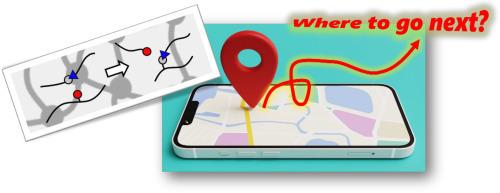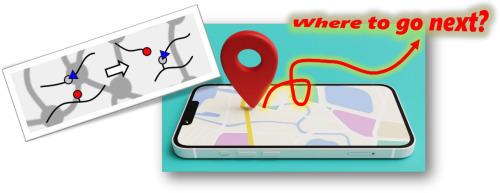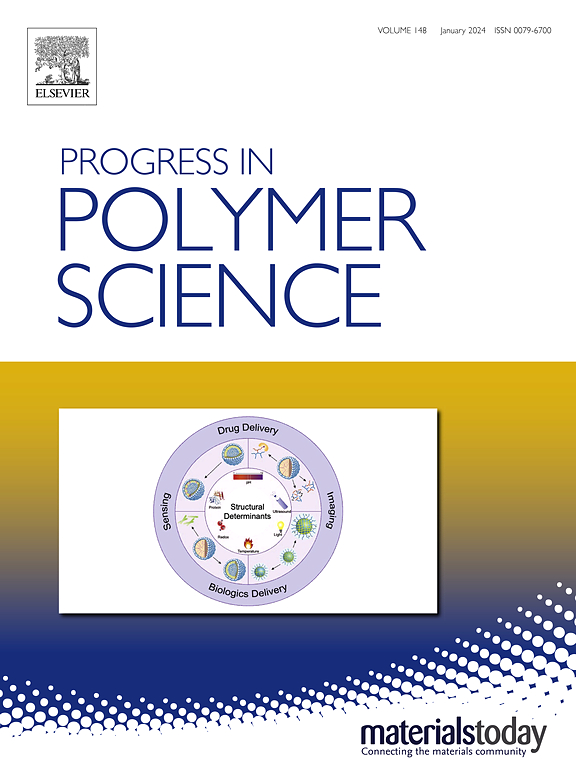Towards the next development of vitrimers: Recent key topics for the practical application and understanding of the fundamental physics
IF 26.1
1区 化学
Q1 POLYMER SCIENCE
引用次数: 0
Abstract
Vitrimers have emerged as an innovative class of functional cross-linked polymers, providing recyclability, healability, and post-cured malleability without distinct flow. These features are attributed to the relaxation and diffusion of network strands through associative bond exchanges within the network. Significant progress has been made in investigating the chemical library and new functionalities, along with comprehensive studies on fundamental physics, including relaxation and rheological characteristics. Despite a rapid increase in research publications over the past decade, critical challenges remain in practical applications, particularly regarding preparation protocols, control of physical properties, and the development of analytical techniques. Unlike existing reviews focusing on vitrimer design and basic features, this article highlights recent crucial topics, such as vitrimer transformation from commodity polymers, the trade-off between processability and mechanical performance, and the control/analysis of stress relaxation time and topology freezing temperature, and an understanding of rheological properties, based on experimental, simulation, and theoretical studies. The transformation using commodity polymers could introduce a novel upcycling technique. The trade-off issues propose unique vitrimer designs utilizing phase-separated structures and post-molding curing. Moreover, given the strong correlation between relaxation/rheological properties and processability/recyclability/healability, their control and analysis are vital for both foundational physics and practical applications. Throughout the article, we provide insights and pose new open questions for the next development of vitrimer materials.


玻璃体的下一个发展:基础物理的实际应用和理解的最新关键主题
Vitrimers作为一种创新的功能性交联聚合物,具有可回收性、可治愈性和后固化延展性,没有明显的流动。这些特征归因于通过网络内结合键交换的网络链的松弛和扩散。在化学文库和新功能的研究方面取得了重大进展,同时在基础物理方面进行了全面的研究,包括弛豫和流变特性。尽管在过去十年中,研究出版物迅速增加,但在实际应用中仍然存在重大挑战,特别是在制备方案,物理性质控制和分析技术的发展方面。不像现有的综述集中在玻璃聚合物的设计和基本特征,这篇文章强调了最近的关键话题,如玻璃聚合物从商品聚合物转化,可加工性和机械性能之间的权衡,应力松弛时间和拓扑冻结温度的控制/分析,以及基于实验,模拟和理论研究的流变特性的理解。使用商品聚合物的改造可以引入一种新的升级回收技术。权衡问题提出了独特的玻璃体设计利用相分离结构和成型后固化。此外,考虑到弛豫/流变特性与可加工性/可回收性/可修复性之间的强相关性,它们的控制和分析对于基础物理和实际应用都至关重要。在整个文章中,我们提供了见解,并提出了新的开放性问题,为下一步发展的玻璃体材料。
本文章由计算机程序翻译,如有差异,请以英文原文为准。
求助全文
约1分钟内获得全文
求助全文
来源期刊

Progress in Polymer Science
化学-高分子科学
CiteScore
48.70
自引率
1.10%
发文量
54
审稿时长
38 days
期刊介绍:
Progress in Polymer Science is a journal that publishes state-of-the-art overview articles in the field of polymer science and engineering. These articles are written by internationally recognized authorities in the discipline, making it a valuable resource for staying up-to-date with the latest developments in this rapidly growing field.
The journal serves as a link between original articles, innovations published in patents, and the most current knowledge of technology. It covers a wide range of topics within the traditional fields of polymer science, including chemistry, physics, and engineering involving polymers. Additionally, it explores interdisciplinary developing fields such as functional and specialty polymers, biomaterials, polymers in drug delivery, polymers in electronic applications, composites, conducting polymers, liquid crystalline materials, and the interphases between polymers and ceramics. The journal also highlights new fabrication techniques that are making significant contributions to the field.
The subject areas covered by Progress in Polymer Science include biomaterials, materials chemistry, organic chemistry, polymers and plastics, surfaces, coatings and films, and nanotechnology. The journal is indexed and abstracted in various databases, including Materials Science Citation Index, Chemical Abstracts, Engineering Index, Current Contents, FIZ Karlsruhe, Scopus, and INSPEC.
 求助内容:
求助内容: 应助结果提醒方式:
应助结果提醒方式:


